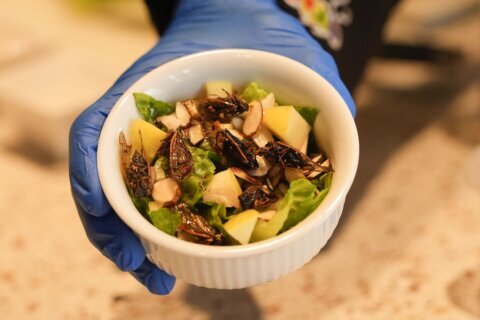PAGE, Ariz. (AP) — Barrett Friesen steers a motorboat toward the shore of Lake Powell, with the Glen Canyon Dam towering overhead. Pale “bathtub rings” line the canyon’s rocky face, starkly illustrating how water levels have slumped in the second-largest U.S. reservoir amid rising demand and a multi-year drought.
The Utah State University graduate student and colleagues are on a mission to save the humpback chub, an ancient fish under assault from nonnative predators in the Colorado River. The reservoir’s decline may soon make things worse, enabling these introduced fish to get past the dam to where the biggest groups of chub remain, farther downstream in the Grand Canyon.
On the brink of extinction decades ago, the chub has come back in modest numbers thanks to fish biologists and other scientists and engineers. But an emerging threat becomes evident in early June as Friesen hauls up minnow traps and gillnets packed with carp, gizzard shad, green sunfish and, ominously, three smallmouth bass.
“Public enemy number one,” he says as lab technician Justin Furby weighs one on a handheld scale.
Smallmouth bass feast on humpback chub in the river’s upper section. Agencies spend millions of dollars there annually to keep those intruders in check. The native fish have been safer below Glen Canyon Dam because it blocks the path to the Lower Colorado and the Grand Canyon, some 200 miles (322 kilometers) downstream — but that may not be true for long.
Bass up in Lake Powell generally prefer warmer waters in shallow areas and at the surface. As reservoir levels drop, they are edging closer to the dam and its penstocks — submerged steel tubes that carry water to turbines, where it generates hydroelectric power and is released on the other side.
If large numbers of bass and other predator fish are sucked into the penstocks, survive and reproduce below the dam, they’ll have an open lane to attack chub and other natives, potentially unraveling years of restoration work and upending the Grand Canyon aquatic ecosystem.
That stretch of river is the only place native fish still dominate the system, said Brian Healy, fisheries biologist for Grand Canyon National Park. “(It) is very unique and we want to keep it that way,” he said.
The dam’s completion in 1963 was a primary reason the chub nearly died out in the river they had inhabited for millions of years. The concrete barrier disrupted water flow, temperatures and sediments where the fish spawned. The chub is resilient but hasn’t evolved to withstand sudden introduction of predatory sport fish.
Although biologically a minnow, the humpback chub can reach 20 inches (51 centimeters) and 2.5 pounds (1.1 kilograms). Silver-sided and white-bellied, with a greenish streak on its back and a distinctive lump behind its head, it prefers calm eddy waters where it feeds on insects.
Its only predator in the Colorado was another native, the pikeminnow, until trout were introduced in the early 20th century to create a sport fishery. Smallmouth bass, even more voracious, arrived in the 1990s.
The chub has gained ground since its listing as endangered in 1967, with about 12,000 in the Grand Canyon’s Little Colorado River, a tributary of the Colorado. Scientists estimate thousands more inhabit the main river farther downstream.
The U.S. Fish and Wildlife Service last year loosened its designation to threatened — no longer a step away from extinction, but still highly vulnerable. Some environmental groups disagree, calling the move premature as the river’s plunge heightens predation danger.
As early as this fall, significant numbers of bass and other nonnatives could slip out through the dam, said Charles Yackulic, a U.S. Geological Survey statistician who has developed computer models of the threat.
Under the Endangered Species Act, government agencies are required to operate in ways that will not “jeopardize the continued existence” of listed animals. That includes infrastructure.
The U.S. Bureau of Reclamation, a branch of the Department of the Interior which operates the dam, is funding Friesen’s fieldwork under Utah State’s Fish Ecology Lab. The team catches fish, notes length and weight, and examines stomachs to see what fish are eating. Their findings about non-natives near the dam will help federal, state and tribal policymakers fine-tune their strategy. A technical team advising policy makers is expected to release a draft plan containing solutions in August.
One measure under consideration if nonnative predators get through the dam is deploying crews to catch as many as possible. They already do that with brown trout upstream, Yackulic said. But it’s expensive and not always successful. Native American tribes such as the Pueblo of Zuni consider the Glen Canyon area sacred and oppose killing fish there, any fish.
“Zuni do not necessarily make distinctions between native and nonnative life forms,” said Arden Kucate, a tribal councilman. “Strong stewardship is very much needed, a philosophy that recognizes and treats all nonhuman life forms as sentient beings.”
Other options include penning off areas downstream from the dam where chub congregate or installing structures such as “bubble curtains” to keep nonnatives in Lake Powell away from the penstocks.
Or cold water also could be released from jet tubes deep in the dam to disrupt smallmouth bass spawning downstream, a move that has been successful in other rivers.
“We can use the dam essentially as a tool,” said Clarence Fullard, a Bureau of Reclamation fish biologist.
That move, however, would sacrifice hydropower generation. To address that, turbines could be installed at the jet tubes — but that would require congressional approval. These steps also depend on having enough cool water in the river. Levels at Lake Powell had been relatively stable for some 15 years, but since 2020, have fallen dramatically.
“Where is the water going to come from to support those needed flows?” said Anne Castle, a senior fellow with the University of Colorado law school and a former assistant U.S. Interior secretary for water and science.
Wayne Pullan, who oversees the Upper Colorado Basin for the Bureau of Reclamation, declined to speculate, although in recent years, states, tribes and Mexico have taken cuts to their supply, both voluntary and forced.
“We’re going to rely on those extraordinary relationships and the history we have of cooperation on the river to come up with solutions,” Pullan said.
In a worst case scenario Lake Powell falls so far that water doesn’t flow past the dam beyond a trickle, a condition known as “deadpool.” It may be unlikely in the next few years, but planners should be looking ahead to “a future in which Lake Powell ceases to exist,” said Taylor McKinnon, senior public lands campaigner with the Center for Biological Diversity, an advocacy group.
The prospect is real enough that the Department of Interior is discussing how to protect native fish if that happens, Pullan said.
Humpback chub wouldn’t be the only victims, McKinnon said. Deadpool also would slash Southwest communities’ water supplies.
“That is a signal of our own self-destruction,” he said.
—-
Flesher reported from Traverse City, Michigan.
—-
The Associated Press receives support from the Walton Family Foundation for coverage of water and environmental policy. The AP is solely responsible for all content. For all of AP’s environmental coverage, visit https://apnews.com/hub/environment
Copyright © 2024 The Associated Press. All rights reserved. This material may not be published, broadcast, written or redistributed.







